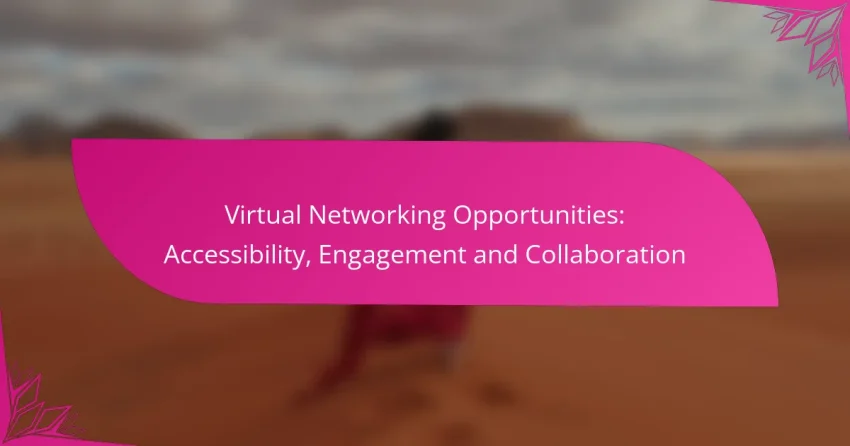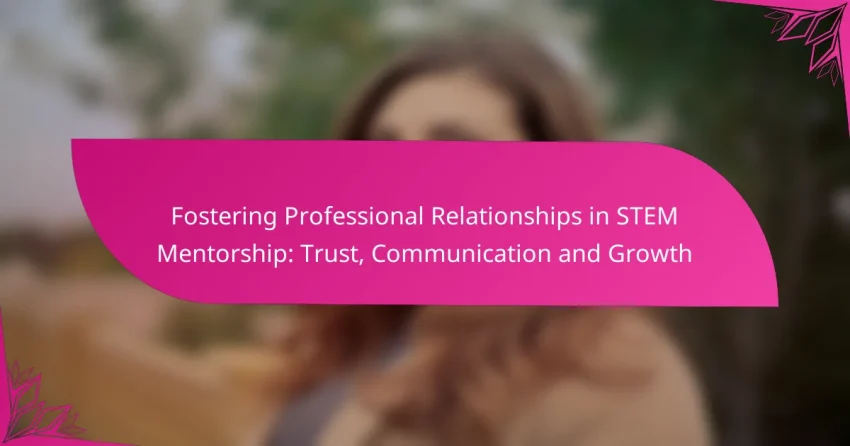Virtual networking presents a transformative opportunity for accessibility, allowing individuals from various backgrounds to connect without geographical constraints. By leveraging interactive tools and real-time communication features, these platforms enhance engagement and collaboration, fostering a sense of community among participants. This inclusive approach not only accommodates diverse needs but also enriches professional and social interactions in…
Category: STEM Mentorship Programs for Women: Networking Opportunities
STEM mentorship programs for women provide essential networking opportunities that can significantly impact their careers in science, technology, engineering, and mathematics. Initiatives like the Society of Women Engineers and Girls Who Code offer valuable resources and guidance, helping women to build professional connections and navigate the challenges of these fields. Engaging with these programs fosters mentorship relationships that empower women to achieve their professional goals.
Fostering Professional Relationships in STEM Mentorship: Trust, Communication and Growth
Fostering professional relationships in STEM mentorship is crucial for creating a supportive and productive environment. Trust, built through clear communication and mutual respect, serves as the foundation for these relationships. By employing effective communication strategies and exploring growth opportunities, both mentors and mentees can enhance their collaborative experience and expand their career prospects. How can…
Alumni Networks in STEM Mentorship: Connections, Resources and Support
Alumni networks play a vital role in enhancing mentorship within STEM fields by facilitating connections among professionals and providing essential resources and support. By leveraging the experiences of former students, these networks create collaborative environments that benefit both current learners and alumni, fostering relationships that can lead to mentorship and career opportunities. How do alumni…
STEM Mentorship Programs: Networking Strategies, Event Participation and Alumni Engagement
STEM mentorship programs play a crucial role in fostering networking opportunities among professionals, students, and alumni, particularly in thriving tech and science hubs. By participating in these programs, individuals can build meaningful connections that may lead to job opportunities and collaborations. Engaging effectively in mentorship events and maintaining alumni relationships can further enhance these benefits,…
What are the best STEM mentorship programs for women in the US?
Some of the top STEM mentorship programs for women in the US include the Society of Women Engineers (SWE) Mentorship Program, Girls Who Code Mentorship Initiative, and Women in Technology International (WITI) Mentorship. These programs offer valuable networking opportunities, guidance, and resources to help women advance in STEM fields.
Society of Women Engineers (SWE) Mentorship Program
The Society of Women Engineers (SWE) Mentorship Program connects women in engineering and technology with experienced professionals. Participants can benefit from one-on-one mentorship, networking events, and workshops designed to enhance skills and career development.
To get involved, women can apply through the SWE website, where they will be matched with mentors based on their interests and career goals. This program is particularly beneficial for those seeking guidance on navigating the engineering workforce.
Girls Who Code Mentorship Initiative
The Girls Who Code Mentorship Initiative aims to support young women interested in computer science and technology. This program pairs high school girls with female mentors in the tech industry, providing insights into career paths and technical skills.
Participants engage in hands-on projects, coding challenges, and networking opportunities. The initiative emphasizes building confidence and community among young women, making it an excellent choice for those starting their tech journey.
Women in Technology International (WITI) Mentorship
Women in Technology International (WITI) Mentorship focuses on empowering women in various technology sectors. The program offers mentorship, resources, and networking opportunities tailored to women at different career stages, from students to seasoned professionals.
WITI provides a platform for mentorship through events, webinars, and online forums. Participants can seek guidance on career advancement, leadership, and industry trends, making it a valuable resource for women looking to excel in technology.
How can women in STEM find networking opportunities?
Women in STEM can find networking opportunities through various channels, including online platforms and local events. Engaging with these resources can help build professional connections and foster mentorship relationships.
Online platforms like LinkedIn
LinkedIn is a powerful tool for women in STEM to connect with industry professionals and potential mentors. By creating a strong profile that highlights skills and achievements, users can attract attention from recruiters and peers alike.
Joining relevant groups and participating in discussions can further enhance visibility. Women should actively engage with content related to their field and share insights to establish themselves as thought leaders.
Local STEM meetups and conferences
Attending local STEM meetups and conferences provides an excellent opportunity for women to network face-to-face. These events often feature workshops, panels, and networking sessions specifically designed to foster connections among attendees.
When attending, it’s beneficial to prepare by researching speakers and participants in advance. Bringing business cards and having a clear elevator pitch can facilitate meaningful conversations and follow-ups.
What are the benefits of STEM mentorship for women?
STEM mentorship offers women significant advantages, including guidance, support, and opportunities that can enhance their careers in science, technology, engineering, and mathematics. These benefits help women navigate challenges, build confidence, and achieve their professional goals.
Increased career advancement
Mentorship in STEM can lead to faster career progression for women. Mentors often provide insights into navigating workplace dynamics, helping mentees identify and seize advancement opportunities. This support can result in promotions, leadership roles, and higher salaries.
For instance, women with mentors may experience a 20-30% increase in job promotions compared to those without mentorship. Actively seeking mentorship can be a strategic move for women aiming to climb the career ladder in STEM fields.
Enhanced skill development
Mentorship fosters skill development by providing tailored guidance and feedback. Mentors can help women identify areas for improvement and recommend resources or training to enhance their technical and soft skills. This personalized approach can significantly boost confidence and competence.
Women in STEM can benefit from learning new programming languages, project management techniques, or communication skills through their mentors. Engaging in regular skill assessments with a mentor can ensure continuous growth and adaptability in a rapidly changing field.
Access to industry connections
Having a mentor often opens doors to valuable industry connections. Mentors can introduce their mentees to key professionals, networks, and events, facilitating opportunities for collaboration and career growth. These connections can be crucial for finding job openings or partnerships.
Women in STEM should actively leverage their mentor’s network by attending industry events or conferences together. Building these relationships can lead to internships, job offers, and collaborative projects that might not be accessible otherwise.
What criteria should women consider when choosing a mentorship program?
Women should evaluate mentorship programs based on their structure, the qualifications of mentors, and the type of support offered. These factors can significantly impact the effectiveness of the mentorship experience and the potential for professional growth.
Program structure and support
The structure of a mentorship program can vary widely, so it’s crucial to understand how it operates. Look for programs that offer a clear framework, including scheduled meetings, goal-setting sessions, and feedback mechanisms. Programs with a defined timeline and regular check-ins tend to provide more accountability and progress tracking.
Additionally, consider the type of support available. Some programs may offer resources like workshops, networking events, or access to industry conferences. These supplementary opportunities can enhance the mentorship experience and provide valuable connections in the STEM field.
Mentor qualifications and experience
When selecting a mentorship program, assess the qualifications and experience of the mentors involved. Ideally, mentors should have a strong background in STEM fields, with relevant educational credentials and professional achievements. This expertise allows them to provide informed guidance and insights.
Furthermore, consider the mentor’s experience in mentoring itself. A mentor who has successfully guided others can offer tailored advice and support. Look for programs that highlight mentor profiles, showcasing their accomplishments and mentoring philosophy to ensure a good match with your goals.
What are effective networking strategies for women in STEM?
Effective networking strategies for women in STEM include actively participating in relevant events and utilizing social media platforms to build connections. These approaches help create valuable relationships and open doors to opportunities in the field.
Participating in workshops and seminars
Workshops and seminars provide an excellent platform for women in STEM to meet peers and industry leaders. Attending these events allows participants to gain insights into current trends while also facilitating discussions that can lead to mentorship opportunities.
When choosing workshops, look for those that focus on specific skills or topics relevant to your career goals. Many organizations offer these events, often at low or no cost, making them accessible for a wide range of participants.
Leveraging social media for connections
Social media platforms, particularly LinkedIn and Twitter, are powerful tools for networking in STEM. By sharing relevant content, engaging with industry discussions, and connecting with professionals, women can enhance their visibility and establish meaningful relationships.
To maximize your social media presence, regularly update your profile, join groups related to your field, and participate in online conversations. Be mindful of maintaining a professional tone and sharing insights that reflect your expertise and interests.
How do mentorship programs impact diversity in STEM fields?
Mentorship programs significantly enhance diversity in STEM fields by providing guidance and support to underrepresented groups, particularly women. These programs foster connections that help mentees navigate challenges, build confidence, and advance their careers in science, technology, engineering, and mathematics.
Promoting inclusive environments
Inclusive environments are crucial for attracting and retaining women in STEM. Mentorship programs create spaces where diverse voices are heard and valued, leading to a culture that encourages participation and innovation. By pairing experienced professionals with mentees, these programs help dismantle barriers and promote equity in the workplace.
To foster inclusivity, organizations should focus on creating mentorship opportunities that are accessible to all. This can include offering virtual mentoring options, hosting networking events, and providing resources tailored to the unique challenges faced by women in STEM. For example, a program might offer workshops on negotiation skills or career advancement strategies specifically for female mentees.
Additionally, organizations should regularly assess the effectiveness of their mentorship initiatives. Gathering feedback from participants can help identify areas for improvement and ensure that the program meets the needs of diverse groups. By continuously refining these programs, organizations can enhance their commitment to diversity and inclusion in STEM fields.



